| Listing 1 - 10 of 10 |
Sort by
|
Book
ISBN: 0070411441 Year: 1991 Publisher: New York, N.Y. McGraw-Hill, Inc.
Abstract | Keywords | Export | Availability | Bookmark
 Loading...
Loading...Choose an application
- Reference Manager
- EndNote
- RefWorks (Direct export to RefWorks)
zv systematics & taxonomy --- Animals --- Animal classification --- Animal systematics --- Animal taxonomy --- Classification --- Systematic zoology --- Systematics (Zoology) --- Taxonomy, Animal --- Zoological classification --- Zoological systematics --- Zoological taxonomy --- Zoology --- Animal systematics, taxonomy, nomencl.
Book
ISBN: 9782807329959 2807329950 Year: 2020 Publisher: Louvain-la-Neuve: De Boeck supérieur,
Abstract | Keywords | Export | Availability | Bookmark
 Loading...
Loading...Choose an application
- Reference Manager
- EndNote
- RefWorks (Direct export to RefWorks)
"Ce livre fait la synthèse des concepts de la systématique et des méthodes employées, jusqu’aux plus modernes à l’œuvre aujourd’hui. Ce livre raconte l'histoire complexe et les révolutions de cette science, tant méthodologiques que conceptuelles. La systématique, ou science de la classification, est une science historique qui intègre les données de la morpho-anatomie, de l’embryologie, de la physiologie et de la paléontologie. Elle connut deux révolutions conceptuelles, dont l’une est toujours à l’œuvre. Ses méthodes ont radicalement changé, et ses résultats récents bouleversent des schémas de pensée solidement ancrés dans les esprits. L’histoire complexe de la systématique, et les renversements tant méthodologiques que conceptuels qui l’ont accompagnée, la rendent difficile à maîtriser. Sous un angle zoologique, ce livre raconte cette histoire en détail et explique clairement ce que la systématique présente doit au passé, mais aussi comment elle doit désormais se couper d’une partie de son passé."--
Animals --- Animaux --- Classification --- Classification. --- Phylogénie. --- Phylogénie. --- Phylogeny --- Phylogenèse --- Animal phylogeny --- Phylogenetics --- Phylogeny (Zoology) --- Biology --- Evolution (Biology) --- Animal classification --- Animal systematics --- Animal taxonomy --- Systematic zoology --- Systematics (Zoology) --- Taxonomy, Animal --- Zoological classification --- Zoological systematics --- Zoological taxonomy --- Zoology
Book
ISBN: 0435618008 9780435618001 Year: 1970 Publisher: London: Heinemann,
Abstract | Keywords | Export | Availability | Bookmark
 Loading...
Loading...Choose an application
- Reference Manager
- EndNote
- RefWorks (Direct export to RefWorks)
Animals --- 57.06 --- Zoology --- -Biology --- Natural history --- Nomenclature and classification of organisms. Taxonomy --- Classification --- -Nomenclature and classification of organisms. Taxonomy --- Classification. --- 57.06 Nomenclature and classification of organisms. Taxonomy --- -57.06 Nomenclature and classification of organisms. Taxonomy --- Animal classification --- Animal systematics --- Animal taxonomy --- Systematic zoology --- Systematics (Zoology) --- Taxonomy, Animal --- Zoological classification --- Zoological systematics --- Zoological taxonomy --- Animals - Classification

ISBN: 0913424587 9780913424582 Year: 2006 Publisher: New York : American Museum of Natural History,
Abstract | Keywords | Export | Availability | Bookmark
 Loading...
Loading...Choose an application
- Reference Manager
- EndNote
- RefWorks (Direct export to RefWorks)
Homology (Biology) --- Animals --- Phylogeny --- zv systematics & taxonomy --- Animal phylogeny --- Phylogenetics --- Phylogeny (Zoology) --- Animal classification --- Animal systematics --- Animal taxonomy --- Classification --- Systematic zoology --- Systematics (Zoology) --- Taxonomy, Animal --- Zoological classification --- Zoological systematics --- Zoological taxonomy --- Zoology --- POY. --- Phylogeny Reconstruction via Optimization of DNA and other Data --- Biology --- Evolution (Biology) --- Anatomy, Comparative --- Morphology --- Animals - Classification
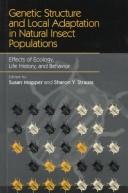
ISBN: 0412080311 1475709048 1475709021 Year: 1998 Publisher: New York : Chapman & Hall,
Abstract | Keywords | Export | Availability | Bookmark
 Loading...
Loading...Choose an application
- Reference Manager
- EndNote
- RefWorks (Direct export to RefWorks)
Providing an essential foundation for evolutionary theory, this comprehensive volume examines patterns of genetic variation within natural insect populations, and explores the underlying mechanisms that lead to the genetic divergence of coexisting organisms. In particular, the text investigates current research on finescale genetic structure in natural insect populations. Internationally renowned scientists offer a wealth of current information not previously published. Part I present case studies of adaptive genetic structure in natural insect populations, including a critical discussion of the strenghts and weaknesses of the experimental methods employed. Part II addresses the ecological mechanisms that produce adaptive genetic structure in natural insect populations. Part III describes how behavioral and life-history patterns influence genetic structure. Finally, Part IV combines theoretical and empirical approaches linking genetic structure at the population level with larger-scale patterns of variation, such as host race formation and speciation. This broad-ranging, interdisciplinary source of information supplies a thorough examination of the mechanisms that promote and impede genetic structure in natural insect populations. It is a book that will be of interest to undergraduate and graduate students, and to researchers in the fields of ecology, evolution, insect and plant systems, entomology, and population genetics.
Insect populations --- Phytophagous insects --- Adaptation --- Genetics --- Genetics. --- Arthropod populations --- Herbivorous insects --- Herbivores --- Insects --- Animal systematics. --- Animal taxonomy. --- Human genetics. --- Evolutionary biology. --- Animal Systematics/Taxonomy/Biogeography. --- Human Genetics. --- Evolutionary Biology. --- Animal evolution --- Animals --- Biological evolution --- Darwinism --- Evolutionary biology --- Evolutionary science --- Origin of species --- Biology --- Evolution --- Biological fitness --- Homoplasy --- Natural selection --- Phylogeny --- Heredity, Human --- Human biology --- Physical anthropology --- Animal classification --- Animal systematics --- Animal taxonomy --- Classification --- Systematic zoology --- Systematics (Zoology) --- Taxonomy, Animal --- Zoological classification --- Zoological systematics --- Zoological taxonomy --- Zoology --- Insect populations. --- Adaptation.
Book
ISBN: 3319251708 3319251724 9783319251707 Year: 2016 Publisher: Cham : Springer International Publishing : Imprint: Springer,
Abstract | Keywords | Export | Availability | Bookmark
 Loading...
Loading...Choose an application
- Reference Manager
- EndNote
- RefWorks (Direct export to RefWorks)
This atlas presents the basic concepts and principles of functional animal anatomy and histology thereby furthering our understanding of evolutionary concepts and adaptation to the environment. It provides a step-by-step dissection guide with numerous colour photographs of the animals featured. It also presents images of the major organs along with histological sections of those organs. A wide range of interactive tutorials gives readers the opportunity to evaluate their understanding of the basic anatomy and histology of the organs of the animals presented. .
Life sciences. --- Animal anatomy. --- Invertebrates. --- Vertebrates. --- Life Sciences. --- Animal Anatomy / Morphology / Histology. --- Animal Systematics/Taxonomy/Biogeography. --- Anatomys --- Histology --- Anatomy, Comparative. --- Histology. --- Anatomy, Comparative --- Dissection --- Comparative Anatomy --- Anatomies, Comparative --- Comparative Anatomies --- Comparative anatomy --- Comparative morphology --- Zootomy --- Surgery --- Zoology --- Morphology (Animals). --- Vertebrata --- Chordata --- Invertebrata --- Animals --- Animal morphology --- Body form in animals --- Morphology --- Animal systematics. --- Animal taxonomy. --- Animal classification --- Animal systematics --- Animal taxonomy --- Classification --- Systematic zoology --- Systematics (Zoology) --- Taxonomy, Animal --- Zoological classification --- Zoological systematics --- Zoological taxonomy --- Animal anatomy --- Biology --- Physiology --- Anatomy
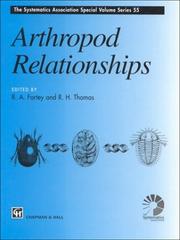
ISBN: 0412754207 9401060576 9401149046 Year: 1998 Volume: 55 Publisher: London : Chapman & Hall,
Abstract | Keywords | Export | Availability | Bookmark
 Loading...
Loading...Choose an application
- Reference Manager
- EndNote
- RefWorks (Direct export to RefWorks)
The arthropods contain more species than any other animal group, but the evolutionary pathways which led to their current diversity are still an issue of controversy. Arthropod Relationships provides an overview of our current understanding, responding to the new data arising from sequencing DNA, the discovery of new Cambrian fossils as direct evidence of early arthropod history, and developmental genetics. These new areas of research have stimulated a reconsideration of classical morphology and embryology. Arthropod Relationships is the first synthesis of the current debate to emerge: not since the volume edited by Gupta was published in 1979 has the arthropod phylogeny debate been, considered in this depth and breadth. Leaders in the various branches of arthropod biology have contributed to this volume. Chapters focus progressively from the general issues to the specific problems involving particular groups, and thence to a consideration of embryology and genetics. This wide range of disciplines is drawn on to approach an understanding of arthropod relationships, and to provide the most timely account of arthropod phylogeny. This book should be read by evolutionary biologists, palaeontologists, developmental geneticists and invertebrate zoologists. It will have a special interest for post-graduate students working in these fields.
RBINS-REPRINT --- Offprints --- Arthropoda --- Arthropods --- Bilateria --- Invertebrates --- Evolution --- Evolution. --- Evolutionary biology. --- Invertebrates. --- Animal systematics. --- Animal taxonomy. --- Evolutionary Biology. --- Animal Systematics/Taxonomy/Biogeography. --- Animal classification --- Animal systematics --- Animal taxonomy --- Classification --- Systematic zoology --- Systematics (Zoology) --- Taxonomy, Animal --- Zoological classification --- Zoological systematics --- Zoological taxonomy --- Zoology --- Invertebrata --- Animals --- Animal evolution --- Biological evolution --- Darwinism --- Evolutionary biology --- Evolutionary science --- Origin of species --- Biology --- Biological fitness --- Homoplasy --- Natural selection --- Phylogeny --- Life sciences. --- Biosciences --- Sciences, Life --- Science
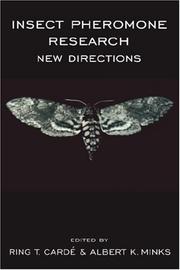
ISBN: 0412996111 1461379261 1461563712 Year: 1997 Publisher: New York : Chapman & Hall,
Abstract | Keywords | Export | Availability | Bookmark
 Loading...
Loading...Choose an application
- Reference Manager
- EndNote
- RefWorks (Direct export to RefWorks)
This book contains the proceedings of the "First International Symposium on Insect Pheromones," which was held at Wageningen, The Netherlands, from March 6 to March 11, 1994. Eighty participants from 17 countries attended the symposium, which turned out to be a unique forum for the exchange of the latest worldwide findings on insect pheromones, an opportunity to discuss and debate unsettled issues, and a mechanism to define new directions in pheromone research and foster interdisciplinary collaborations. The meeting comprised five sessions representing the breadth of disciplinary interest in pheromones, a typical charac teristic of this research area. In the sessions the following topics were presented: (1) control of pheromone production (organized by W. L. Roelofs), (2) sensory processing of pheromone signals (T. L. Payne), (3) neuroethology of pheromone mediated responses (T. C. Baker), (4) use of pheromones in direct control (A. K. Minks and R. T. Card6), and (5) evolution of pheromone communication (c. LOfstedt). All sessions started with a series of 30-minute lectures, after which ample time was reserved for discussion. In each session some participants were asked to serve as discussants and to initiate and stimulate discussion, and a rapporteur was recruited to make notes of these discussions and to summarize the general trends emerging from the session. The general program ming of the symposium was in the hands of R. T. Carde, A. K. Minks, and T. L. Payne.
Pheromones. --- Plant and Crop Sciences. Plant and Crop Protection --- Integrated Control, Integrated Pest Management. --- Pheromones --- Phéromones --- Hormones --- Semiochemicals --- Sex recognition (Zoology) --- Applied ecology. --- Ecology . --- Animal systematics. --- Animal taxonomy. --- Neurosciences. --- Applied Ecology. --- Ecology. --- Animal Systematics/Taxonomy/Biogeography. --- Neural sciences --- Neurological sciences --- Neuroscience --- Medical sciences --- Nervous system --- Animal classification --- Animal systematics --- Animal taxonomy --- Classification --- Systematic zoology --- Systematics (Zoology) --- Taxonomy, Animal --- Zoological classification --- Zoological systematics --- Zoological taxonomy --- Zoology --- Balance of nature --- Biology --- Bionomics --- Ecological processes --- Ecological science --- Ecological sciences --- Environment --- Environmental biology --- Oecology --- Environmental sciences --- Population biology --- Ecology --- Environmental protection --- Nature conservation --- Animals
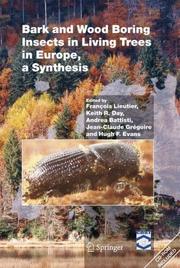
ISBN: 1402022409 1402022417 9786611045753 9781402022418 9781402022401 Year: 2007 Publisher: Dordrecht, Netherlands : Springer,
Abstract | Keywords | Export | Availability | Bookmark
 Loading...
Loading...Choose an application
- Reference Manager
- EndNote
- RefWorks (Direct export to RefWorks)
For the first time, a synthesis on the research work done in Europe on all Bark And Wood Boring Insects In Living Trees (BAWBILT) is presented. As final product of a four-year research project gathering together 100 scientists from 24 countries, the book is the fruit of a real collective synthesis in which all European specialists have participated. It reviews and comments on all the European literature, while considering the biological (trees, insects, associated organisms, and their relationships) and forest management aspects. However, although focused on the European forest, it also compares the available information and interpretations to those concerning similar species in other continents. It ends with propositions of research priorities for Europe. The book is directed to all scientists and students concerned with forest entomology and ecology, as well as to forest managers and all scientific public interested in forest biology.
Forest insects --- Control --- Ecology. --- Entomology. --- Evolution (Biology). --- Forest insects - Europe. --- Forests and forestry. --- Life sciences. --- Agriculture --- Earth & Environmental Sciences --- Plant Sciences --- Evolutionary biology. --- Forestry management. --- Life Sciences. --- Animal Systematics/Taxonomy/Biogeography. --- Evolutionary Biology. --- Forestry Management. --- Forest entomology --- Animal systematics. --- Animal taxonomy. --- Ecology . --- Forest animals --- Insects --- Trees --- Diseases and pests --- Balance of nature --- Biology --- Bionomics --- Ecological processes --- Ecological science --- Ecological sciences --- Environment --- Environmental biology --- Oecology --- Environmental sciences --- Population biology --- Forest administration --- Forest plants --- Forest resource administration --- Forest resource management --- Forest stewardship --- Forest vegetation management --- Forestry management --- Forests and forestry --- Stewardship, Forest --- Vegetation management, Forest --- Ecosystem management --- Natural resources --- Animal evolution --- Animals --- Biological evolution --- Darwinism --- Evolutionary biology --- Evolutionary science --- Origin of species --- Evolution --- Biological fitness --- Homoplasy --- Natural selection --- Phylogeny --- Animal classification --- Animal systematics --- Animal taxonomy --- Classification --- Systematic zoology --- Systematics (Zoology) --- Taxonomy, Animal --- Zoological classification --- Zoological systematics --- Zoological taxonomy --- Zoology --- Ecology --- Management --- Administration --- Forest insects - Control - Europe.
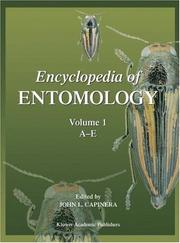
ISBN: 0792386701 0306483807 1402048564 Year: 2005 Publisher: Dordrecht : Springer Netherlands : Imprint: Springer,
Abstract | Keywords | Export | Availability | Bookmark
 Loading...
Loading...Choose an application
- Reference Manager
- EndNote
- RefWorks (Direct export to RefWorks)
The Encyclopedia of Entomology brings together the talents of over 350 distinguished entomologists from 36 countries to provide a detailed, global overview of insects and their close relatives, including taxonomy, behavior, ecology, physiology, history, and management. All the major groups of arthropods are treated, as are many important families and individual species. The Encyclopedia also covers physiology, genetics, ecology, behavior, insect relationships with people, medical entomology, and pest management. Detailed listings are also complemented by more than 1100 illustrations. Featured in this important work are unique biographical sketches of the hundreds of entomologists who have made important contributions to the discipline since its origin. Presented in three volumes and including a fully searchable and easily accessed online version, the Encyclopedia of Entomology is the most complete reference work in this field. In addition to being a must for Entomology departments around the world, the Encyclopedia also serves as a handy reference for scientists and students in related areas of science such as agronomy, animal science, botany, ecology, human disease, evolutionary biology, forestry, genetics, horticulture, parasitology, toxicology and zoology. Please note that this publication is available as print only OR online only OR print + online bundle. Save 75% when purchasing the bundle. For more information on the online version please type the publication title into the search box above, then click on the "eReference" version.
Entomology --- Entomologists --- Invertebrates & Protozoa --- Zoology --- Health & Biological Sciences --- Insect scientists --- Entomologie --- Entomologistes --- Zoology and Animal Sciences --- Zoology and Animal Sciences. --- Life sciences. --- Ecology. --- Evolutionary biology. --- Plant science. --- Botany. --- Invertebrates. --- Life Sciences. --- Animal Systematics/Taxonomy/Biogeography. --- Evolutionary Biology. --- Plant Sciences. --- Reference Works. Encyclopaedias --- Subject Encyclopaedias --- Encyclopedias. --- Encyclopédies --- Evolution (Biology). --- Animal evolution --- Animals --- Biological evolution --- Darwinism --- Evolutionary biology --- Evolutionary science --- Origin of species --- Biology --- Evolution --- Biological fitness --- Homoplasy --- Natural selection --- Phylogeny --- Invertebrata --- Botanical science --- Phytobiology --- Phytography --- Phytology --- Plant biology --- Plant science --- Natural history --- Plants --- Balance of nature --- Bionomics --- Ecological processes --- Ecological science --- Ecological sciences --- Environment --- Environmental biology --- Oecology --- Environmental sciences --- Population biology --- Ecology --- Animal systematics. --- Animal taxonomy. --- Ecology . --- Animal classification --- Animal systematics --- Animal taxonomy --- Classification --- Systematic zoology --- Systematics (Zoology) --- Taxonomy, Animal --- Zoological classification --- Zoological systematics --- Zoological taxonomy --- Insects --- Zoologists --- Floristic botany --- Evolution (Biology)
| Listing 1 - 10 of 10 |
Sort by
|

 Search
Search Feedback
Feedback About UniCat
About UniCat  Help
Help News
News